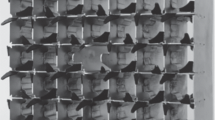Abstract
The single-phase heat transfer characteristics in a PWR fuel assembly are important. Many investigations attempt to obtain the heat transfer characteristics by studying the flow features in a 5 × 5 rod bundle with a spacer grid. The field synergy principle is used to discuss the mechanism of heat transfer enhancement using mixing vanes according to computational fluid dynamics results, including a spacer grid without mixing vanes, one with a split mixing vane, and one with a separate mixing vane. The results show that the field synergy principle is feasible to explain the mechanism of heat transfer enhancement in a fuel assembly. The enhancement in subchannels is more effective than on the rod’s surface. If the pressure loss is ignored, the performance of the split mixing vane is superior to the separate mixing vane based on the enhanced heat transfer. Increasing the blending angle of the split mixing vane improves heat transfer enhancement, the maximum of which is 7.1%. Increasing the blending angle of the separate mixing vane did not significantly enhance heat transfer in the rod bundle, and even prevented heat transfer at a blending angle of 50°. This finding testifies to the feasibility of predicting heat transfer in a rod bundle with a spacer grid by field synergy, and upon comparison with analyzed flow features only, the field synergy method may provide more accurate guidance for optimizing the use of mixing vanes.
Similar content being viewed by others

References
MCCLUSKY H L, HOLLOWAY M V, BEASLEY D E, et al. Development of swirling flow in a rod bundle sub-channel[J]. Journal of Fluids Engineering, 2002, 124(3): 747–755.
CHANG S K, MOON S K, BAEK W P, et al. Phenomenological investigations on the turbulent flow structures in a rod bundle array with mixing devices[J]. Nuclear Engineering and Design, 2008, 238(3): 600–609.
IKEDA K and HOSHI M. Flow characteristics in spacer grids measured by rod-embedded fiber laser doppler velocimetry[J]. Journal of Nuclear Science and Technology, 2007, 44(2): 194–200.
AGBODEMEGBE V Y, CHENG X, AKAHO E H K, et al. An investigation of the effect of split-type mixing vane on extent of cross-flow between sub-channels through the fuel rod gaps[J]. Annals of Nuclear Energy, 2016, 88: 174–185.
LEE C Y, SHIN C H, PARK J Y, et al. An experimental investigation on turbulent flow mixing in a simulated 3×3 dual-cooled annular fuel bundle using particle image velocimetry[J]. Nuclear Engineering and Design, 2013, 260: 134–144.
CUI X Z, KIM K Y. Three-dimensional analysis of turbulent heat transfer and flow through mixing vane in a sub-channel of nuclear reactor[J]. Journal of Nuclear Science and Technology, 2003, 40(10): 719–724.
HOLLOWAY M V, MCCLUSKY H L, BEASLEY D E, et al. The effect of support grid features on local, single-phase heat transfer measurements in rod bundles[J]. Journal of Heat Transfer, 2004, 126(1): 43–53.
HOLLOWAY M V, CONOVER T A, MCCLUSKY H L, et al. The effect of support grid design on azimuthal variation in heat transfer coefficient for rod bundles[J]. Journal of Heat Transfer, 2005, 127(6): 598–605.
HOLLOWAY M V, BEASLEY D E, CONNER M E. Single-phase convective heat transfer in rod bundles[J]. Nuclear Engineering and Design, 2008, 238(4): 848–858.
DOMINGUES-ONTIVEROS E E, HASSAN Y A, CONNER M E, et al. Experimental benchmark data for PWR rod bundle with spacer-grids[J]. Nuclear Engineering and Design, 2012, 253: 396–405.
CONNER M E, HASSAN Y A, DOMINGUES-ONTIVEROS E E. Hydraulic benchmark data for PWR mixing vane grid[J]. Nuclear Engineering and Design, 2013, 264: 97–102.
GUO Z Y, LI D Y, WANG B X. A novel concept for convective heat transfer enhancement[J]. International Journal of Heat and Mass Transfer, 1998, 41(14): 2221–2225.
GUO Zengyuan, TAO Wenquan, SHAH R K. The field synergy (coordination) principle and its applications in enhancing single phase convective heat transfer[J]. International Journal of Heat and Mass Transfer, 2005, 48(9): 1797–1807.
CAI Jun, HUAI Xiulan, YAN Runsheng, et al. Numerical simulation on enhancement of natural convection heat transfer by acoustic cavitation in a square enclosure[J]. Applied Thermal Engineering, 2009, 29(10): 1973–1982.
LI Yuqiang, LIU Gang, RAO Zhenghua, et al. Field synergy principle analysis for reducing natural convection heat loss of a solar cavity receiver[J]. Renewable Energy, 2015, 75: 257–265.
GOU Chenhua, CAI Ruixian and LIU Qibin. Field synergy analysis of laminar forced convection between two parallel penetrable walls[J]. International Journal of Heat and Mass Transfer, 2009, 52(3–4): 1044–1052.
HE Y L, TAO W Q, SONG F Q, et al. Three-dimensional numerical study of heat transfer characteristics of plain plate fin-and-tube heat exchangers from view point of field synergy principle[J]. International Journal of Heat and Fluid Flow, 2005, 26(3): 459–473.
TAO Y B, HE Y L, HUANG J, et al. Three-dimensional numerical study of wavy fin-and-tube heat exchangers and field synergy principle analysis[J]. International Journal of Heat and Mass Transfer, 2007, 50(5–6): 1163–1175.
CHEN G M, TSO C P, HUNG Y M. Field synergy principle analysis on fully developed forced convection in porous medium with uniform heat generation[J]. International Communications in Heat and Mass Transfer, 2011, 38(9): 1247–1252.
CHAO Yanmeng, YANG Lixin, ZHANG Yuxiang, et al. CFD Evaluation of turbulence model on heat transfer in 5×5 rod bundle[J]. Atomic Energy Science and Technology, 2014(10): 1782–1789.(in Chinese)
Author information
Authors and Affiliations
Corresponding author
Additional information
Supported by National Natural Science Foundation of China(Grant No. 51376022)
YANG Lixin, born in 1969, is an ssociate professor at Beijing Jiaotong University, China. His research direction is complex flow, heat and mass transfer process.
ZHOU Mengjun, born in 1993, is currently a postgraduate candidate at Beijing Jiaotong University, China. Her research direction is flow and heat transfer characteristics in fuel assembly.
TIAN Zihao, born in 1992 and major in thermal power engineering, is currently a postgraduate candidate at Beijing Jiaotong University, China.
Rights and permissions
About this article
Cite this article
Yang, L., Zhou, M. & Tian, Z. Heat transfer enhancement with mixing vane spacers using the field synergy principle. Chin. J. Mech. Eng. 30, 127–134 (2017). https://doi.org/10.3901/CJME.2016.0621.076
Received:
Revised:
Accepted:
Published:
Issue Date:
DOI: https://doi.org/10.3901/CJME.2016.0621.076



